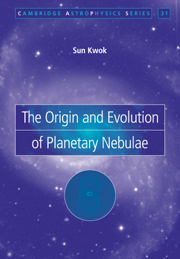Book contents
- Frontmatter
- Contents
- Preface
- 1 History and overview
- 2 Ionization structure of planetary nebulae
- 3 Nebular line radiation
- 4 Nebular continuum radiation
- 5 The neutral gas component
- 6 The dust component
- 7 Observations of the central star of planetary nebulae
- 8 Morphologies of planetary nebulae
- 9 Problems and questions
- 10 Asymptotic giant branch stars – progenitors of planetary nebulae
- 11 Evolution of the central stars
- 12 Formation of planetary nebulae
- 13 Dynamical evolution of planetary nebulae
- 14 Protoplanetary nebulae – the transition objects
- 15 Evolution to the white dwarf stage
- 16 Distances to planetary nebulae
- 17 Comparison between evolutionary models and observations
- 18 PN in the galactic context
- 19 Chemical abundances
- 20 Planetary nebulae in other galaxies
- 21 Concluding remarks
- References
- Appendix List of symbols and abbreviations
- Subject index
16 - Distances to planetary nebulae
Published online by Cambridge University Press: 04 November 2009
- Frontmatter
- Contents
- Preface
- 1 History and overview
- 2 Ionization structure of planetary nebulae
- 3 Nebular line radiation
- 4 Nebular continuum radiation
- 5 The neutral gas component
- 6 The dust component
- 7 Observations of the central star of planetary nebulae
- 8 Morphologies of planetary nebulae
- 9 Problems and questions
- 10 Asymptotic giant branch stars – progenitors of planetary nebulae
- 11 Evolution of the central stars
- 12 Formation of planetary nebulae
- 13 Dynamical evolution of planetary nebulae
- 14 Protoplanetary nebulae – the transition objects
- 15 Evolution to the white dwarf stage
- 16 Distances to planetary nebulae
- 17 Comparison between evolutionary models and observations
- 18 PN in the galactic context
- 19 Chemical abundances
- 20 Planetary nebulae in other galaxies
- 21 Concluding remarks
- References
- Appendix List of symbols and abbreviations
- Subject index
Summary
Stars on the main sequence (MS) obey a well-defined luminosity-spectral type relationship. The method of “spectroscopic parallax” assumes that a star of a certain spectral type will have a certain intrinsic luminosity, and by comparing with its visual magnitude, it is possible to derive its distance. However, the central stars of many PN cannot be observed, and even in the case where a visual magnitude is available, their high temperatures imply that large bolometric corrections are required. Whereas stars on the MS remain stationary in the same position on the H-R diagram, CSPN undergo large changes in temperature and luminosity over their lifetime. As a result, any derivations of distances from stellar properties are necessarily model dependent.
Except for a few cases of nearby PN where trigonometric parallaxes are possible, or in cases where there is a MS binary companion, most of the distances to PN have to be estimated from their nebular properties. By making certain assumptions on the nebular structure, distances can be derived by measurements of fluxes, angular sizes, electron densities, and so on. These methods are collectively called statistical distances.
A well-determined distance scale for PN is necessary for the investigation of the space density, galactic distribution, total number of PN, and the birth rate of PN in the Galaxy (see Chapter 18). Unfortunately, after many years of efforts, distances to PN remain controversial.
- Type
- Chapter
- Information
- The Origin and Evolution of Planetary Nebulae , pp. 177 - 184Publisher: Cambridge University PressPrint publication year: 2000



